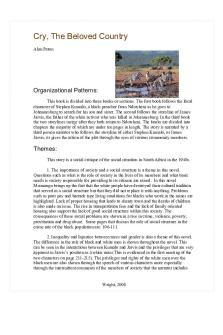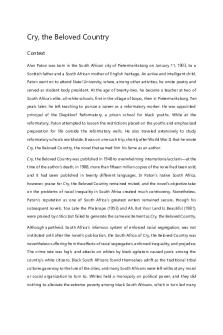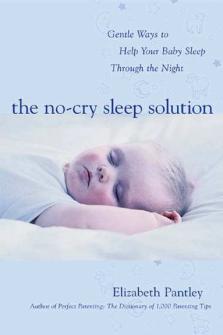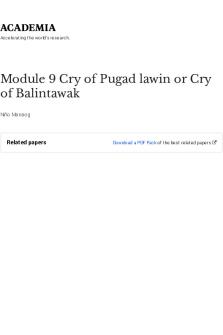Cry, the Beloved Country - Diary PDF

| Title | Cry, the Beloved Country - Diary |
|---|---|
| Course | StuDocu Summary Library EN |
| Institution | StuDocu University |
| Pages | 7 |
| File Size | 254 KB |
| File Type | |
| Total Downloads | 72 |
| Total Views | 138 |
Summary
Cry, the Beloved Country...
Description
Cry, The Beloved Country Alan Paton
Organizational Patterns: This book is divided into three books or sections. The first book follows the focal character of Stephen Kumalo, a black preacher from Ndotsheni as he goes to Johannesburg to search for his son and sister. The second follows the storyline of James Jarvis, the father of the white activist who was killed in Johannesburg. In the third book the two storylines merge after they both return to Ndotsheni. The books are divided into chapters the majority of which are under ten pages in length. The story is narrated by a third person narrator who follows the storyline of either Stephen Kumalo, or James Jarvis, or gives the action of the plot through the eyes of various community members.
Themes: This story is a social critique of the social situation in South Africa in the 1940s. 1. The importance of society and a social structure is a theme in this novel. Questions such as what is the role of society in the lives of its members and what basic needs is society responsible for providing to its citizens are raised. In this novel Msimangu brings up the fact that the white people have destroyed their cultural tradition that served as a social structure but that they did not replace it with anything. Problems such as poor pay and barrack type living conditions for blacks who work in the mines are highlighted. Lack of proper housing that leads to shanty town and the deaths of children is also made an issue. The rise in transportation fees and the lack of family oriented housing also support the lack of good social structure within this society. The consequences of these social problems are shown in a rise in crime, violence, poverty, prostitution and drug abuse. Some pages that discuss the role of social structure in the crime rate of the black population are: 106-111. 2. Inequality and Injustice between races and gender is also a theme of this novel. The difference in the role of black and white men is shown throughout the novel. This can be seen in the interactions between Kumalo and Jarvis and the privileges that are very apparent in Jarvis’s position as a white man (This is evidenced in the first meeting of the two characters on page 211-215). The privileges and rights of the white men over the black men are also shown through the speech of various characters more especially through the intermittent comments of the members of society that the narrator includes
Wright, 2008
throughout the novel. The difference in the roles of men and women are also highlighted through the characters of the girl (Absalom’s wife on page 99), Gertrude, and Mrs. Lithebe. Comments about the harsh and limited role of women are made by the narrator when he speaks about Mrs. Kumalo as well as female members of the black community. 3. The paralyzing and destructive consequences of fear is also a theme of this novel. Fear is discussed more and more frequently as Kumalo begins to see the troubles and problems that are facing his people. The affects of fear on all of the characters vary. The white members of the community react by increasing police officers and security in their community. The black population seems to respond with an increasing feeling of hopelessness. 106-111 4. Departing from tradition is a forth theme in this novel. The dissolving role of tradition in the lives of the African people shows up frequently in this novel. Large indications of the break down show up in the movement of many black people from the smaller rural villages in the country to the bigger cities to work in the mines. Smaller less detectable erosions appear in the comments from Kumalo about when people do not call him Umfundisi which is the appropriate title for a black preacher in a village. This issue is linked to the role of social structures within society. A scene that discusses the departure from tradition takes place between Stephan Kumalo and his brother John on page 65-69. 5. The balance between justice and forgiveness is another theme in this novel. The trial of Absalom and the concluding speech of the judge highlight the aspects of what determines justice and forgiveness in the eyes of this particular judge (found on page 233-236). The perspectives of the everyday society members also reflect what people at this time considered just or worthy of forgiveness. The acts of the two main characters can be examples of justice and forgiveness. Kumalo attempts to take many people into his house to help and provide for them, including Gertrude, her son, and his son’s wife. Jarvis helps the villagers by finding an agricultural specialist to help them as well as building a damn for crops and rebuilding the village church building.
Setting: The story begins in Ndotsheni, a small village in Natal which is a providence of South Africa. Throughout the novel we follow the focal character, Kumalo, to Johannesburg and eventually back to Ndotsheni at the end. It is set in the 1940s. Information about the location of Ndotsheni and Johannesburg would be useful for the students to learn before they read the book. Other information that would be useful would include the size of both cities, the type of landscape they have and the amount of people in both cities.
Point of View:
Wright, 2008
A third person omniscient narrator narrates this tale. The narrator switches from telling the tale from various characters’ point of views as well as presenting an overall narration of events from the omniscient narrator. The focal character for the majority of the story is Kumalo. Another person from whose perspective we get the story is James Jarvis. We also get perspectives from a montage of typical South African citizens as well as from Mrs. Lithebe.
Allusion: There are many Biblical allusions in this story. The names themselves are names found in the Bible, the stories behind the names are also similar. Absalom is the name of the son of King David who rebels against his father. In the story Kumalo’s son Absalom also rebels against his father. Absalom wants to have his child be named Peter if it is a boy. Peter was one of Christ’s disciples who denied Christ, later wept and repented. This could be a symbol of Absalom’s true repentance.
Plot: This story has several distinct plot lines. The way that the narrator switches from following one specific character to describing events through random members of society helps add depth and perspective to the overall story.
Grammar: Grammar in this novel is fairly unusual and unorthodox. In stead of using quotation marks Paton uses dashes to indicate when someone is talking. This can be confusing but does seem to add simplicity to the speech and almost a rushed feeling as if you are compelled to read even more quickly through conversations.
Tragedy: This could be determined a tragedy in regards to the two deaths in the book, Arthur Jarvis and Absalom Kumalo. Jarvis never fell in the literary sense of giving into character weaknesses but his death was a huge loss to the community members. Absalom on the other hand fell from a good Christian son of a preacher to a petty thief who eventually commits murder. Gertrude’s story is also a tale of tragedy in regards to her fall from a good Christian woman twice. The first time she is a normal married woman, the second time she was about to turn her life around and was even considering becoming a nun. The fall of traditional Tribal society is also a potential tragedy. Msimangu states in the book. “The tragedy is not that things are broken. The tragedy is that they are not mended again.” p. 56
Irony: Wright, 2008
Arthur Jarvis is killed by a native black youth committing a crime while in the middle of writing an article entitled, “The Truth about Native Crime” which was meant to help fix the problems of native crime. A description of John Kumalo sitting like a chief in his store after he has commented to Kumalo and Msimangu about how the chiefs were a hindrance to the black people is very ironic (65).
Tone: The tone is very well set by the mechanics of the writing. A hurried and informal tone is created by using an alternate method of quoting speech, such as dashes. The author also creates a sense of importance and feeling in the prayer that Kumalo offers in front of the villagers in Ndotsheni by leaving additional spaces in between the words. This indicates pauses in the speech and adds to the emotion of the prayer.
Symbol: The land is used to symbolize the dying, sick society. The land in inexplicable tied to the cultural traditions of the people. It is clearly shown in the book that because the land is sick and unhealthy the villagers then are forced to move to the city to be able to provide for themselves. Not only are the people forced to abandon their traditional homes and move to the city because of the sickness of the land but once they get there they become sick as well, as is the case with Gertrude and Absalom. Descriptions of the land throughout the story are connected to the fears of the people.
Characterization: We get a picture of who Kumalo is through his speech, interaction with others and the thoughts that the character lets us hear. His interaction with others such as when he plays with his nephew and when he takes pity on the girl when the other two men scorn her indicates what type of person he is. Through the narrator at times we also get the thoughts of Kumalo about his interactions with others. An example would be the guilt that he feels when he lies to his brother John and when he purposefully tries to hurt the girl. Actions such as playing gently and lovingly with his small nephew show inexplicitly that he is a kind loving man whereas taking pity on the girl when others don’t indicate explicitly that he is a merciful person.
Resolution: At the end of the story Mr. Jarvis and Kumalo rebuild the village of Ndotsheni, Absalom is executed, and Gertrude turns back to her former sinful life in Johannesburg. The resolution is one that has hope in it but has a large measure of sadness in it as well. The problems of the broken society have some answers provided but the problem is not completely solved.
Wright, 2008
Affective Issues: Students can relate to the issue of trying to figure out how much social structures, beliefs, and traditions should play a role in their lives. Because they are becoming older and having to participate more and more with societal structures that have been set up, such as drivers’ licensing laws they are becoming more and more aware of how those structures affect them. Many may also be trying to recon ciliate how their beliefs and traditions fit into society. The older that students get the more they become aware of the different roles of men and women. They are trying to learn how to interact with one another and to understand what makes women and men different. Discussing issues about what the roles of men and women should be helps students to figure out and understand how each gender in turn wishes to be treated, including what rights and privileges each gender deserves. Fear is a universal issue for all human beings and students will have to face fears at many points in their life. We often wish that such experiences will be limited for our students but fear is something that they will have to deal with most likely over and over again. Therefore, the more that students learn to recognize and deal with fear the better they will be able to handle it. Problems such as bullies, taking tests and other much more frightening issues are a few examples of situations involving fear. Students often struggle with the balance between justice and mercy. This can be evident in even the simple interactions students have with those in authority such as their parents and teachers. Pulling apart the trial and discussing whether or not Absalom deserved mercy or not is a powerful way for students to discern the reasons and need for mercy.
Vocabulary Issues: This book is set in the culture of South Africa and therefore has a lot of cultural specific language. A list in the back of each book gives the definition and pronunciation of unknown African words and names to help with this issue. Some examples are: Kumalo, Msimangu, Lithebe, Tixo, Umfundisi, Ixopo, Inkosi. Apart from the African words there are other vocabulary words that can be used to instruct students. Here is a list of words found in this novel that can be used for vocabulary instruction: Tributary, retribution, revitalize, vitality, adherent, advocate, voracious, subsequent. The wonderful thing about these words is that they can be taught in the framework of a study of the roots in words such as the prefixes re, ad, and sub.
Background Knowledge:
Wright, 2008
Information about the customs and culture of African Tribal societies could be taught before students read the novel. The history of South Africa would also be helpful to know. This would include information about the Boers, white Dutch settlers, who came in and set up trading posts and invented the Afrikaans language. It would also include the British attempts to set up a colony when gold was found. The first attempt resulted in war between the Boer, the British and the Black population and the Boers won. The second attempt came when more gold was found and resulted in the victory of the British over the other two populations. Students should also become aware of civil rights movements, their tactics and the basis for their movement (aka what rights they were denied). Information about bus boycotting and strikes would be useful to understand before reading the novel.
Implications for Students of Diversity Students of diversity would be particularly interested in this novel because it introduces the complexities of a completely different culture. Some might even enjoy it because they might be from South Africa or they might find aspects of the South African culture that is similar to their own. This story also focuses on aspects of discrimination between people of different cultures and students of a different cultural background might be able to relate to such discrimination. Also students who are from a minority culture would be able to relate with the struggles that the characters in this novel experience because these cultures live so closely with two cultures that differ from their own.
Gender Issues: The issue of gender is an evident one in this novel. There are many female characters in the novel that demonstrate the role of women in this society. Through the characters of Mrs. Kumalo and Mrs. Lithebe we see that women serve a subservient role to men. Their role is to serve everyone around them and often is they are suffering they must do it in silence. Nameless women characters from Johannesburg also illustrate this role. From Gertrude and the girl we learn that because women have very little rights or means of taking care of themselves they often fall prey to the trap of abuse where they turn to prostitution to survive or boyfriends that impregnate them and leave them.
Central Question/ Enduring Issue: The enduring issue that this novel deals with is how students need to interact with the people around them. Not only does it cover making sure the structural formats are in place to be able to interact well properly in a society with others but it covers taking into consideration the differences between people. This includes cultural, racial and gender difference.
Research Issues/Project Ideas: Wright, 2008
Students can research what happened after this book was published in South Africa. The apartheid system was put into place in 1948, the same year that this book was published and a long hard battle ensued to remove it from the system. Students can do a research project on important leaders who helped abolish the apartheid system, Nelson Mandela being one of them. They can focus on what tactics he used and what it was that eventually overcame the social problems in Africa. Students can write a paper about whether or not they think that the social injustices and problems are truly gone from the South African society. They can also research to see if there are other areas in the world today that have social or racial discrimination like South Africa did. Students can also research and compare and contrast leaders of the abolishment of apartheid with leaders from the civil rights movement. Students would ask questions such as what did they have in common and did the same tactics work for both leaders or did they have tactics that were specific to their region and culture that seemed to work better?
Informational and Functional Texts: 1. Maps, guides and pamphlets to South Africa, more specifically the providence of Natal. http://www.sa-venues.com/maps/south-africa-provinces.htm -map http://www.fordham.edu/halsall/mod/1953geyer.html This is a speech given to the Rotary Club of London on August 19, 1953 giving the reasons why apartheid is the best policy for all races in South Africa. 2. Martin Luther King Jr. and Nelson Mandela speeches as well as various other speeches and articles written by activists against discrimination and segregation. http://www.fordham.edu/halsall/mod/1990Mandela.html Speech by Nelson Mandela on the negative effects of apartheid. http://www.usconstitution.net/dream.html Martin Luther King Jr., “I Have a Dream” Speech about negative effects of segregation. 3. Approved internet website that give information the bus boycott in America and civil rights protest tactics as well as tactics of the anti-apartheid activists. http://www.montgomeryboycott.com/frontpage.htm This site has links to various applicable information such as biographies, newspaper articles and a timeline. 4. The official government document of the apartheid could be useful in helping the students see the reality of it and help expose them to a variety of texts. It would also provide information on the apartheid such as the length of it and its fall and the specific details of the separation and segregation. http://www-csstudents.stanford.edu/~cale/cs201/apartheid.hist.html This site gives the history of apartheid and includes statistics concerning information like the income differences between blacks and whites and land allocation. 5. The movie version of this film might be helpful in helping students to picture and feel the discrimination that went on at this time. There are two versions of this novel and they would need to be previewed to look for relevance. http://www.imdb.com/title/tt0112749/ This is a site about the movie which includes a link to buy the movie online.
Wright, 2008...
Similar Free PDFs

Cry, the Beloved Country - Diary
- 7 Pages

Cry, the Beloved Country Cry - Diary
- 12 Pages

Cry, the Beloved Country Essay
- 3 Pages

The no Cry Sleep Solution.pdf
- 273 Pages

The Country Wife Summary
- 8 Pages

The Country Wife - 1111
- 1 Pages

The Language You Cry In
- 2 Pages

The brand leader - Beloved Brands
- 19 Pages

Quiz19 - Beloved
- 1 Pages

Learning diary
- 16 Pages

CRY-of-Rebellion - nnnkjnjnknn
- 2 Pages

Diary entry
- 2 Pages

12:3:19 - The ending of Beloved
- 3 Pages
Popular Institutions
- Tinajero National High School - Annex
- Politeknik Caltex Riau
- Yokohama City University
- SGT University
- University of Al-Qadisiyah
- Divine Word College of Vigan
- Techniek College Rotterdam
- Universidade de Santiago
- Universiti Teknologi MARA Cawangan Johor Kampus Pasir Gudang
- Poltekkes Kemenkes Yogyakarta
- Baguio City National High School
- Colegio san marcos
- preparatoria uno
- Centro de Bachillerato Tecnológico Industrial y de Servicios No. 107
- Dalian Maritime University
- Quang Trung Secondary School
- Colegio Tecnológico en Informática
- Corporación Regional de Educación Superior
- Grupo CEDVA
- Dar Al Uloom University
- Centro de Estudios Preuniversitarios de la Universidad Nacional de Ingeniería
- 上智大学
- Aakash International School, Nuna Majara
- San Felipe Neri Catholic School
- Kang Chiao International School - New Taipei City
- Misamis Occidental National High School
- Institución Educativa Escuela Normal Juan Ladrilleros
- Kolehiyo ng Pantukan
- Batanes State College
- Instituto Continental
- Sekolah Menengah Kejuruan Kesehatan Kaltara (Tarakan)
- Colegio de La Inmaculada Concepcion - Cebu


